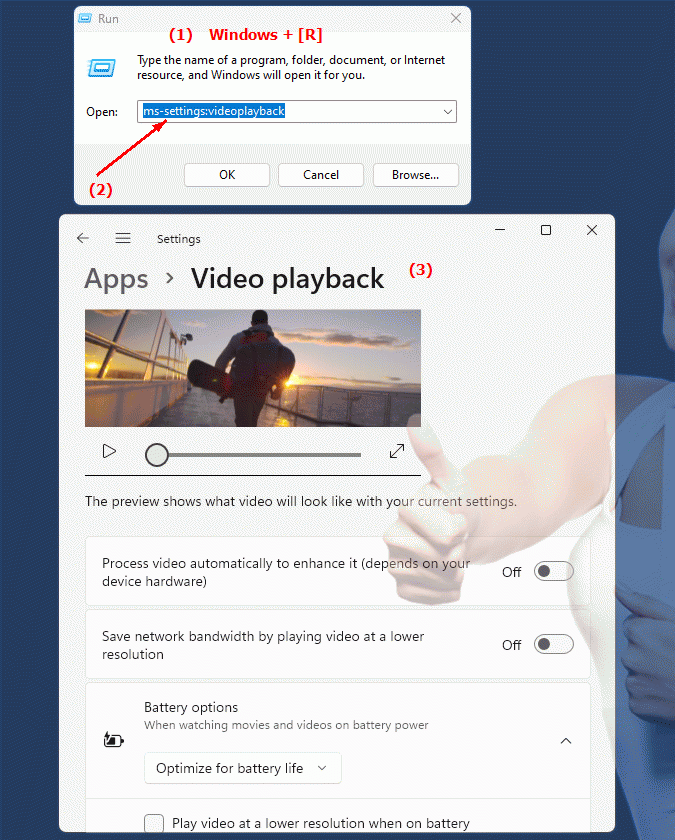The URL and protocol URL "ms-settings:videoplayback" opens the video playback settings in Windows 10 und 11 .
This feature allows users to adjust various video playback settings, including options for video quality, hardware acceleration, and other playback options. Here is a detailed description of the availability of this feature in different Windows versions, along with the corresponding build numbers:
1. ms-settings:videoplayback
2. Availability under Windows
3. Other useful commands in the Windows settings
1. The Command ms-settings:videoplayback
1. Press Windows R on your keyboard.2. Simply execute the following command: ms-settings:videoplayback
(This command can also be used as a desktop shortcut.)
3. You can complete the operation by pressing OK or by pressing [Enter].
(... see Image-1 Point 1 to 3)
The settings explained above are now available to you in Windows 10, 11 or 12.
This solves the following problems and questions.

1b. This solves the following problems and questions.
In which versions of Windows can the function for adjusting video playback be set?What is the meaning of hardware acceleration when playing videos and how can I set it up in the system?
Can users in Windows adjust the video quality for different video files, and if so, how do they do it?
How do I change general playback options on a Windows system?
Are there differences in the availability of video playback settings between different versions of Windows?
Can you access the video playback settings in Windows from the Settings menu and if so, where can you find this option?
Is it possible that video playback options vary from computer to computer based on the version of the operating system used?
What role do build numbers play in describing the availability of certain features in different versions of Windows?
2. Available in Windows 10, 11, 12 and the corresponding build numbers.
Windows10
- Availability:
Video playback settings are available in Windows 10 starting with version 1703 (Creators Update). This version introduced improvements to multimedia and video settings, including the ability to configure various video playback options.
- Build number:
The "ms-settings:videoplayback" URL is available starting with Windows 10 version 1703 (build 15063). In this version, users can navigate directly to the video playback settings to enable or disable hardware acceleration, as well as manage other video playback options.
Windows11
- Availability:
Windows 11 will retain video playback functionality, with potential improvements and a modernized user interface that integrates seamlessly with the new Windows 11 design concept. Windows 11 offers expanded video playback options and improves the user experience.
- Build number:
The "ms-settings:videoplayback" URL is available in Windows 11 starting with version 21H2 (Initial Release). This version was released on October 5, 2021. In this version, users can still navigate to the video playback settings and manage the available video playback options, including enabling or disabling hardware acceleration and other settings.
Windows12
- Availability:
Windows 12 is expected to continue to support video playback, possibly with additional improvements or new features to align with the latest versions of the operating system. Windows 12 is expected to offer additional options or enhanced features for video playback.
- Build number:
The exact build number for the feature's introduction in Windows 12 will be provided after the first versions of the operating system are released. However, the feature is expected to be available starting from the early builds of Windows 12 and include the latest video playback features.
Summary
The "ms-settings:videoplayback" URL is available in Windows 10 starting with version 1703 (build 15063) and remains available in Windows 11 starting with version 21H2, as well as in Windows 12. This URL allows users to directly access the video playback settings to adjust options such as hardware acceleration and other playback settings. The exact build number for Windows 12 will be provided after the initial releases, but the feature is expected to be included in the early versions of the new operating system.
